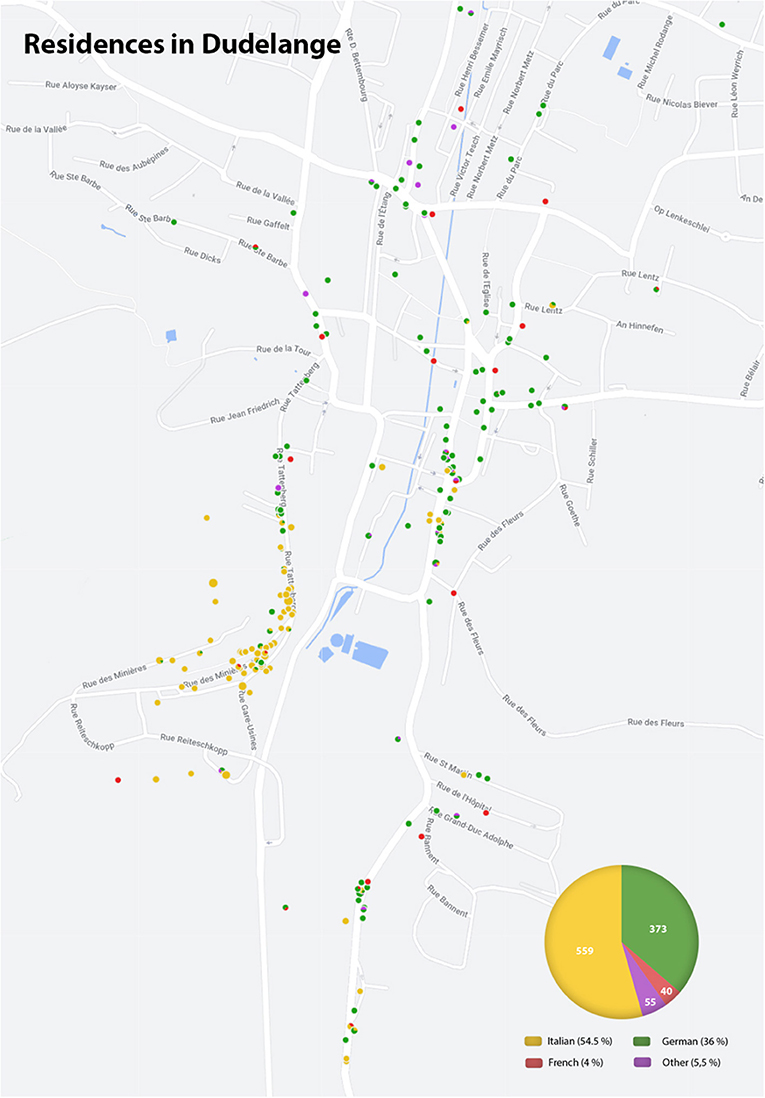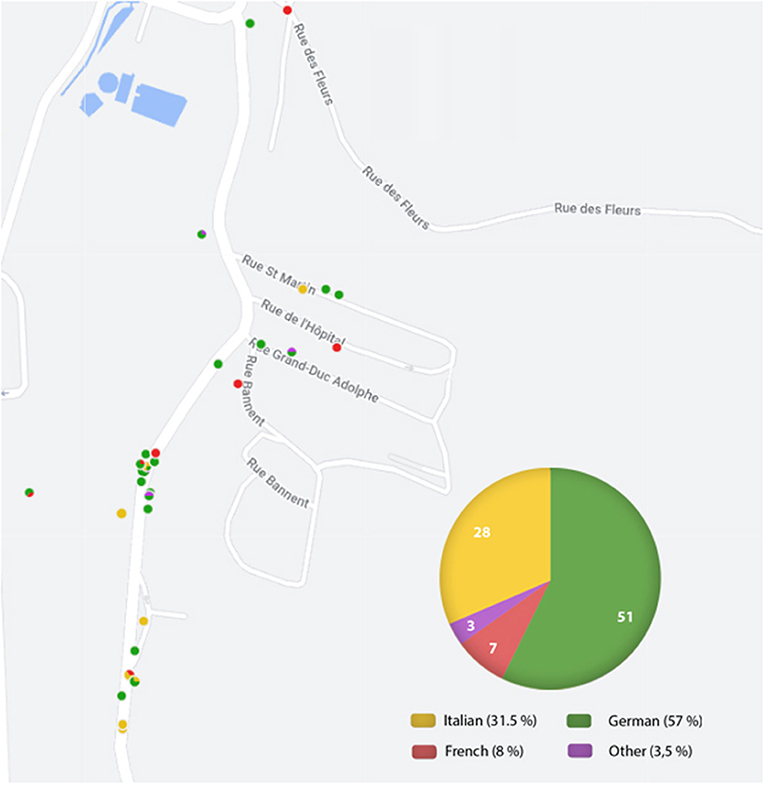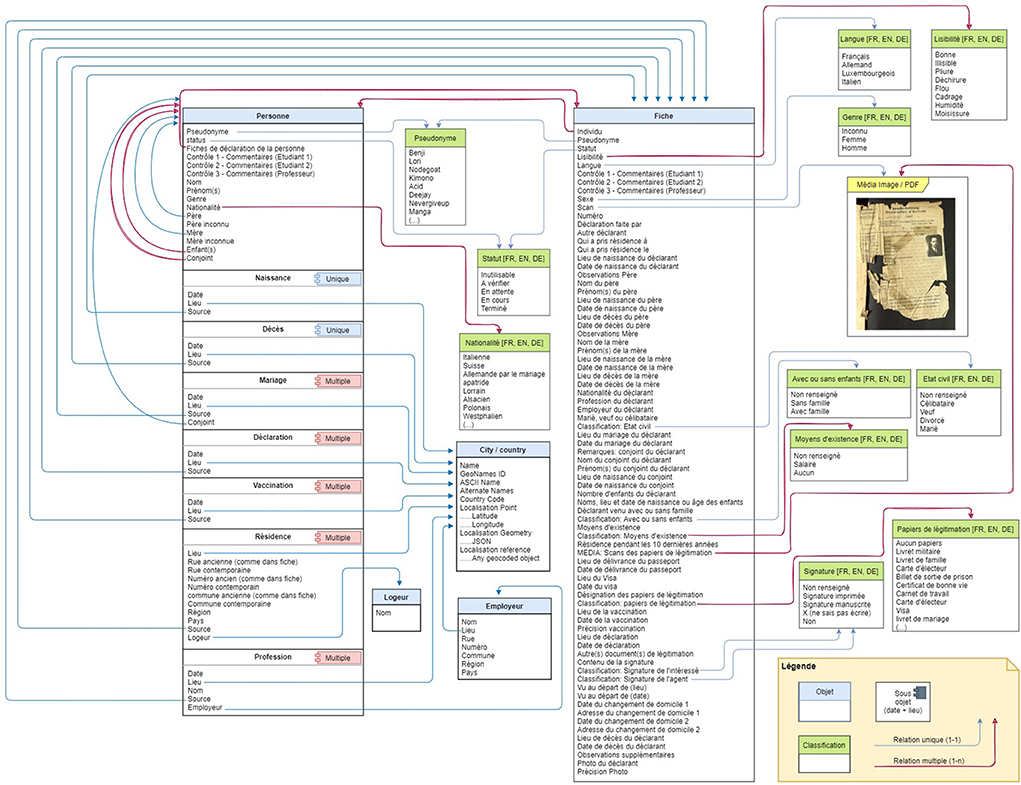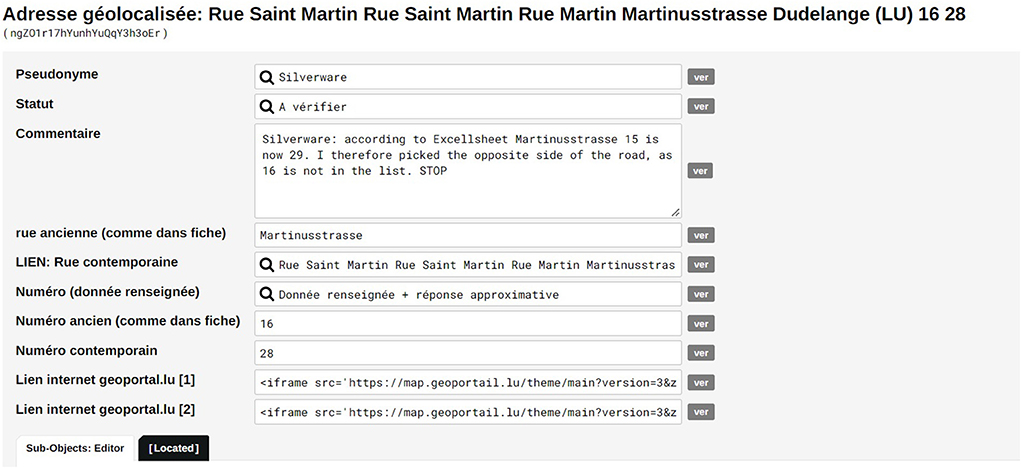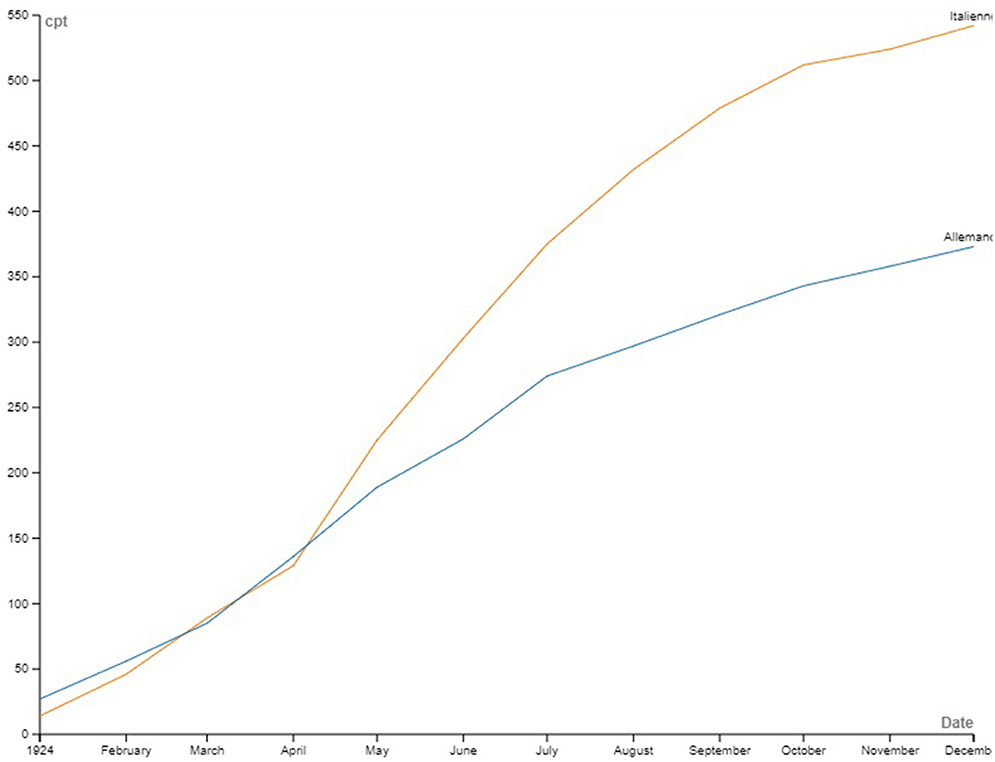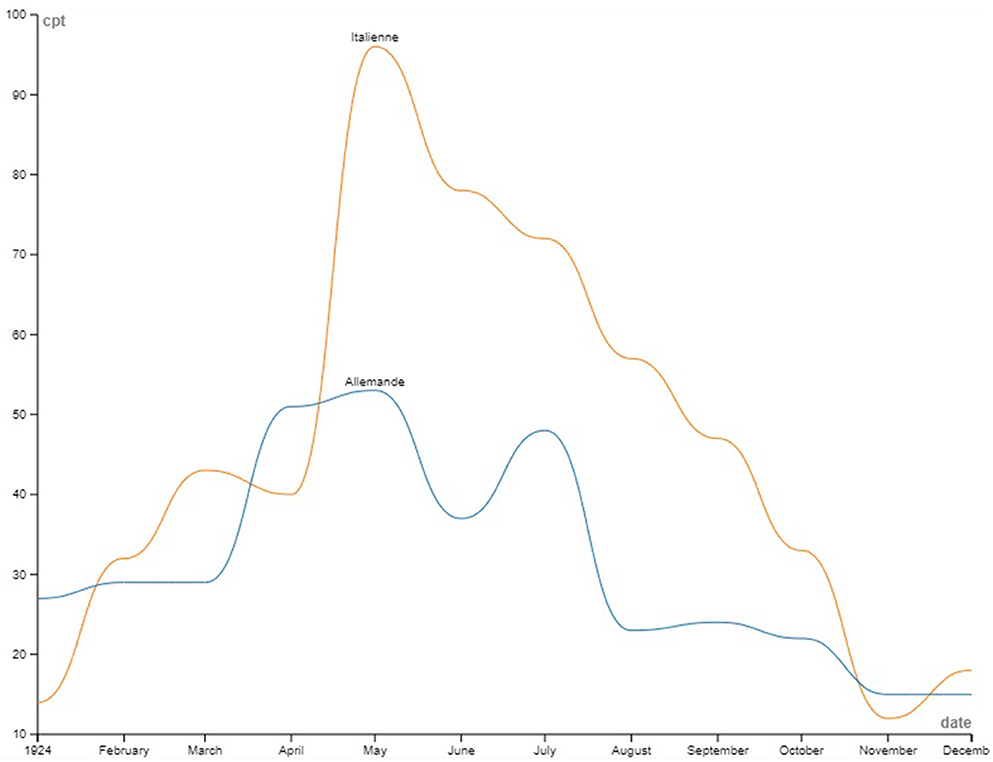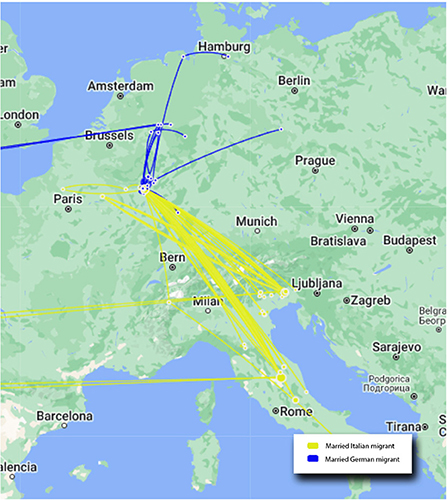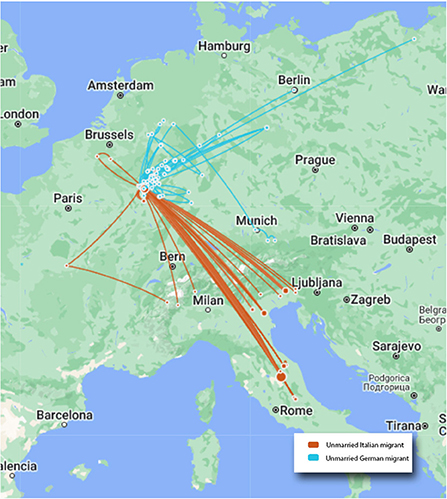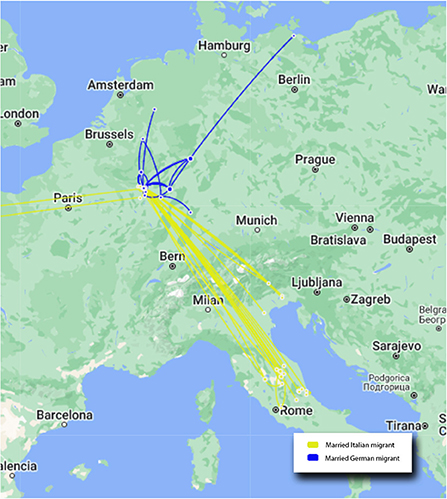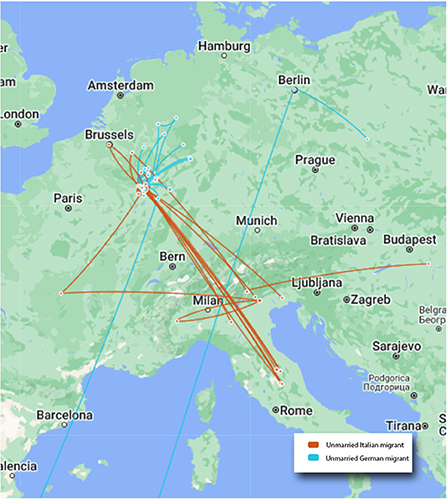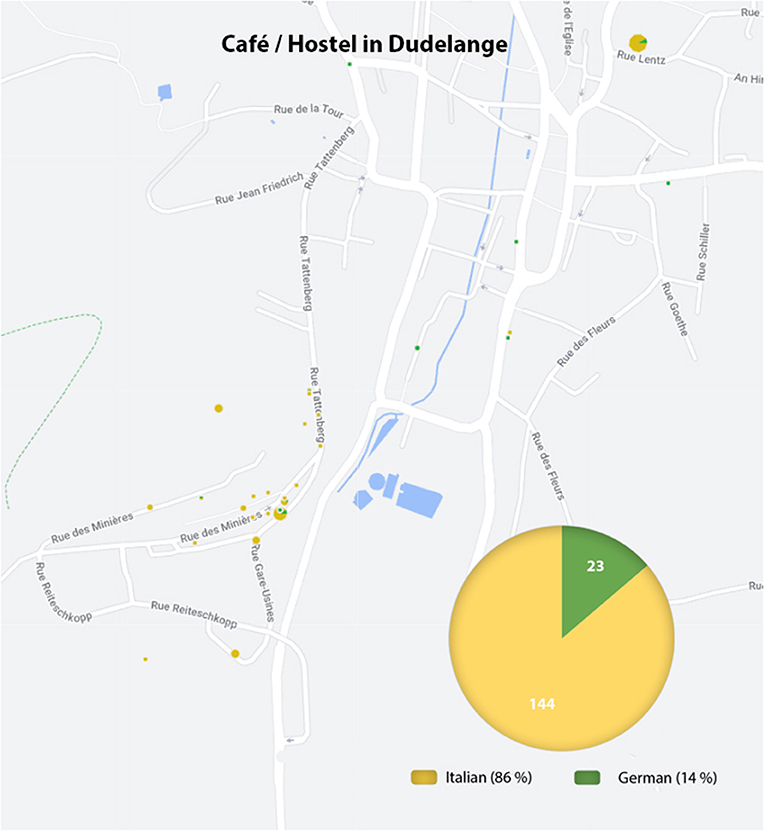- Centre for Contemporary and Digital History, University of Luxembourg, Esch-sur-Alzette, Luxembourg
Since the late 19th century, foreigners moving to Luxembourg have been required to declare their residency at the local municipality upon arrival. New digital technologies have made it possible to analyze the wealth of information contained in arrival declaration forms. This article offers a first digital analysis of a selection of these sources for the municipalities of Dudelange and Differdange in the mid-1920s. This was a pivotal period during which migratory flows to the Minett region, one of Europe's most dynamic industrial regions characterized by its iron mines and steelworks, were increasing and diversifying. Using a digital hermeneutic approach, the article evaluates the choices, opportunities and difficulties involved in using these sources within the virtual environment nodegoat. It presents insights gained by visualizing migration paths and settlement patterns: differences in mobility between Italian and German (un)married migrants, the case of the owner of a café and hostel (café-pension) in Dudelange who hosted Italian migrants from his place of birth, and the fact that social networks among family members and friends were also active on the road, with family members waiting for each other in the French transit town of Trieux. We end our article by identifying avenues for further research.
Introduction
Ernesto Leperoni was 35 years old when he arrived in Luxembourg in March 1924 and was registered by a civil servant under the Aliens Police Act of December 30, 1893, which required all foreigners to declare their arrival. This newcomer to Differdange was born in 1889 in Genga in central Italy, which provided a large contingent of workers for the steel and mining industry in the Minett iron region. In addition to civil status data, the declaration form includes detailed information on the declarant's places of residence over the previous 10 years. Ernest Leperoni had emigrated to the United States 10 years earlier. In 1912 he arrived in Minnesota, where he remained for 6 years. He then crossed the border and lived for 8 months in Winnipeg, Canada, before returning to the European continent, probably driven out by post-war unemployment.
He returned to his native village in 1919, where he married a young woman 3 years later. His vaccination certificate indicates that he was still in Genga in 1924. We then find him in Villerupt, a French town on the border with Luxembourg, where he stayed for 3 months before moving to Mont-Saint-Martin near Longwy, a French working-class town he also left after 3 months. Arriving in Differdange without his wife and three children, he stayed with Biondi, a fellow Italian living in Rue de l'Usine, who sublet him a room. He was hired by Hadir,1 one of the largest integrated steelworks in the world, as a wheeler, handling loads of materials for fusion. Leperoni traveled with a fellow Italian born in the same town, who was registered in Differdange on the same day at the same address.2
When Hein de Haas, Stephen Castles and Mark J. Miller wrote that “France was the only Western European country to experience substantial immigration in the interwar years,” they forgot about Luxembourg (2005, p. 92). Historical studies on migration to Luxembourg are few in number, despite the scale of the migratory phenomenon. This article offers a first digital analysis of arrival declaration forms, an important source revealing migrants' complex trajectories to and settlement patterns in Luxembourg. These forms show varied migratory paths, mobility practices and social networks. New digital technologies have made it possible to analyze the wealth of information contained in the vast collections of declaration forms archived in Luxembourg's former industrial towns in detail. Digital humanities tools facilitate a spatiotemporal analysis of the past by using different scales. Zooming in and out “between distant and close, macro and micro (…) becomes the norm” (Burdick et al., 2016, p. 30). “Space and time, brought together,” (Zephyr, 2015, p. 416) argued, “become visible as co-present elements in history through the analysis of movement (…) visualizations of historical data can capture something of the sense of movement”.
This article analyzes declaration forms completed by migrants when they arrived in one of two Luxembourgish municipalities, Dudelange or Differdange, in 1924. This was a pivotal year during which migratory flows to the Minett region, one of Europe's most dynamic industrial regions characterized by its iron mines and steelworks, were increasing and diversifying. The two municipalities lie on the French-Luxembourg border, not far from the center of the mining region in Esch-sur-Alzette. They were linked to other municipalities by an extensive cross-border public transport network. Both above and below ground, the area was crisscrossed by mining concessions and industrial complexes that extended beyond national borders.
We present the new insights gained by visualizing migration paths to and settlement patterns in Luxembourg and offer a critical methodological reflection on how these findings were gathered by means of a digital hermeneutic approach. The article starts out by evaluating the choices, difficulties and opportunities related to the sources and nodegoat software. It then presents an analysis of the data through geographical visualizations. We end our article by identifying avenues for further research.
Research question
This article presents new findings obtained from creating and interpreting geographic visualizations of migration paths leading to Luxembourg and settlement patterns in the country. More specifically, it addresses the following questions: 1. At what points and in what ways was geographical visualization a precondition for the interpretation of our data?, 2. What role did consecutive geographical visualization play in our analytical thinking?, and 3. How did geographical visualization support an analysis of migration to and between the two municipalities of Dudelange and Differdange?
The findings are presented using a digital hermeneutic approach consisting of (digital) source criticism, tool criticism and visualization criticism (Reisinger, 2010). Such an approach encourages reflection on the conditions of knowledge production for digitized data (Stiegler, 2014). Digital source criticism is used to analyze the quality of the data for digital display. Tool criticism involves reflecting on the possibilities of the software program nodegoat. Visualization criticism includes an assessment of other possibilities to present and interpret the spatiotemporal characteristics of migration to Luxembourg. The digital hermeneutic approach enables us to provide an evaluation of the difficulties in mapping space and time in the humanities. Our study should be seen as a first step toward a more tailored research project addressing specific research questions about migration to and within the Minett region through the analysis of larger data sets composed of different historical sources.
Historiography of the Minett region
Luxembourg entered the industrial era at the end of the 19th century following the invention of the Thomas-Gilchrist dephosphorization process for the exploitation of iron ore. The Minett region, which became the main center for iron ore mining in Europe and the second largest iron ore deposit in the world, covers a vast area from the south of Nancy in France to southern Luxembourg and south-east Belgium. A single working environment crossing national borders with no natural obstacles arose. Within a few decades, this industrial space dominated by the mono-industry of iron formed a dense network of steel and mining companies. Given the strong demand for industrial workers as well as the low availability of local workers who were employed in agriculture, industrial companies extended their recruitment policies. Foreign workers were invited from neighboring countries first, and from the Italian peninsula and young interwar states in Central and Eastern Europe afterwards (Klessmann, 1978; Hohengarten, 1995, p. 194–199; Ponty, 2005).
Our case study contributes to research in migration history, foregrounding a regional and transnational approach (Pisarevskaya et al., 2020, p. 457–458). Let us here take the example of Dudelange, one of the two municipalities under study, which grew from a village into a thriving town in response to the frantic pace of development of industrial production and the influx of foreign workers. Dudelange saw the birth of a district referred to as “little Italy” near its steelworks (Rainhorn, 2005; Blanc-Chaléard et al., 2007). The demographic explosion required industrial plants and the state to develop an active housing policy, but these initiatives could not mask the poor housing conditions in overcrowded dwellings (Lehners, 1991, p. 9–12). Political upheavals, social and trade union movements and economic crises subsequently led to an outflux of migrants (Galloro, 2001, p. 93–126).
Although the historiography of the steel company ARBED offers a detailed picture of Luxembourg's past industrial strategy in comparison to the rest of Europe (Chomé, 1964), the history of other Luxembourgish mining and steel companies remains in the shadows (Leboutte et al., 1998, p. 161–188). On the other side of the border, in Lorraine, more detailed studies focus on the evolution of the (foreign) labor market (Walter, 1935; Prêcheur, 1959). A history of migration to Luxembourg in the interwar years still needs to be written. Figures show that whereas in 1913, 60% of the workers employed in the steel and mining industry were foreigners, i.e., 11,000 (mainly Italians and Germans) out of a total of 19,000 workers, by 1930, 55,831 foreigners were registered in Luxembourg. The workforce of the plant in Dudelange reached 1,799 foreigners in 1927 out of a total workforce of 4,105 people. These figures hide the turnover; between 1919 and 1939, there were 13,503 declarations of arrival of foreigners in Dudelange and 22,349 in Differdange (Scuto, 2010, p. 13–38).
What do we know about the profile of foreign workers in Luxembourg? The priest Gallo (1987) indicated that many of them came from various places within Italy at different speeds and at different times. The historian Scuto (2010, p. 12–38) noted that most Italian migrants arriving in Luxembourg were from northern and central Italy, a finding confirmed for Dudelange by Trinkaus (1984, p. 151). More detailed studies on the characteristics of foreign workers are available for those who settled across the border in France. The French sociologist Serge Bonnet and the historian Gérard Noiriel conducted studies in Lorraine documenting the influence of foreigners on the development of trade unions (Bonnet, 1976; Noiriel, 2019). Moreover, the geographer Sömme (1930) showed the high mobility of different foreign workers crossing national borders within the Minett region. More recently, the sociologist Galloro (2001) analyzed the role of industrial companies and the government in the process of recruiting and dismissing foreign labor in Lorraine, as well as the strategies of foreign workers to circumvent the various restrictions associated with their status.
The Second Industrial Revolution led to a strong influx of new populations of foreign workers in Luxembourg. With the rise of nation-states and the increase in tensions between neighboring nations following the Franco-Prussian War of 1870, border control became a major concern (Noiriel, 2001, p. 125–144; Scuto, 2012, p. 155–156). To exert more control over this highly mobile foreign population, the Luxembourg government decided to legislate, like the governments in other countries. An Act adopted on December 30, 1893 required foreigners to declare their arrival in Luxembourg.3 Control was further stepped up by a decree adopted on May 31, 1934, which introduced special identity cards for foreigners.4
Heavy industry slowly restarted to recruit foreign workers in the aftermath of the First World War and experienced rapid growth from 1922 onwards (Trausch, 2017, p. 185–198). The foreign population entering the municipality of Dudelange rose from 446 in 1923 to 1,115 in 1924. By 1923, various laws had been passed to restrict the influx of foreign workers. The decree of August 21, 1923 required all employers to apply for an authorization from at the Directorate General of Agriculture, Industry and Social Welfare indicating that a given vacancy could not be occupied by a Luxembourg national. In addition, the Act of October 28, 1920 aimed to protect the national population against competition from foreign workers suspected of social dumping and wage stagnation by stemming the influx of foreigners.5
Before discussing the geographic visualizations, the article will present and evaluate the sources and the digital tool used, offering an overview of how we used declaration forms as sources and reflecting on our initiatives to expand the source base.
Sources and digital source criticism
Our research is based on one-page typed arrival declaration forms meticulously completed by civil servants. They contain spatiotemporal information reconstructing the life and journey of the declarant, including birth, marriage, places of residence before and upon arrival in Luxembourg and employment. A first overview of the data shows that of the 1,115 declarants in Dudelange, there were 663 Italians and 452 Germans (including 10 migrants whose regional origins from the Territory of the Saar Basin were indicated specifically, as it functioned under a League of Nations mandate) (Figure 1). Other nationalities were less well represented, including 18 French nationals and 20 individuals from Alsace and Lorraine, a regional particularity that reflected the fact that citizenship issues were still being negotiated after the territory had changed from German to French sovereignty following the First World War (Zind, 1979, p. 128–129). Other nationalities with 10 or more migrants included Polish (some of whom were referred to as “Russ Polen” given their former residence in the Russian Empire) (15), Belgian (12) and Austrian (understood as formerly belonging to the Austro-Hungarian empire, although Czech nationality was indicated separately on one occasion) (10). Individuals migrated from Spain (4), what was called Russia (despite the establishment of the Soviet Union in 1917) (3), Switzerland (2), the United States (2) and the Netherlands (1), among others. The fact that 980 declarations were made by men and 245 by women is explained by the fact that married couples who arrived together were declared through the husband. We counted 107 married and 138 unmarried female declarants. In general, these married women traveled alone (though often with their children) to join their husbands. In 1924, 21 married husbands arrived in Dudelange by themselves and were joined by their spouses within the same year and one woman arrived 2 months before her husband.6 As most migrants needed some time to find and be able to afford suitable living conditions for a family, the spouses often remained separated for a longer period.
Although this article, like many studies in migration history, follows the categorizations imposed by policy makers (Schrover and Moloney, 2013, p. 9), it nevertheless critically assesses the quality of the data by asking how civil servants completed their task in practice. Data in the original sources were sometimes inaccurate. The places of birth and marriage of Russian emigrants in Cyrillic script were not correctly transcribed by Luxembourg officials. The former Russian prisoner of war Theodor Wolkow, for example, declared “Gribatschi” as his place of birth, which we were unable to geolocate with the help of the GeoNames portal.7 A second difficulty was imprecise dating as a result of descriptions such as “for 2 and a half years,” “3 weeks” or even more vague wordings such as “since the war.” Information included in the field “Residence during the last 10 years” could offer a succession of estimated periods, forcing the researcher to make approximate calculations or ultimately to accept a certain margin of error. Luigi Bison, for example, arrived in Dudelange in December 1924 and declared eleven successive previous places of residence, all of approximate duration. He lived for 6 months in Creola, 2 years in Moyeuvre-Grande, 4 months in Belgium and 1 year in Creola. Previously, he had spent 9 months in Moyeuvre-Grande, 6 months in Creola and 5 years in the Italian Army. Before the war, he mentioned having lived for 6 months in Duisburg in Germany, 1 year in Oberhausen and 9 months in Dortmund, and in Creola before that (Figure 2).8 The historian Andrei Petruş stated that “Nodegoat does not currently include an option to flag fictional data” (2020, 35), but we included a separate field next to a date in our data model, where we indicated whether that date was exact or calculated by the researcher, in order to offer as accurate an interpretation as possible of our geographical visualizations. Although temporal descriptions such as “military service” could be approximately equated to the duration of the war, if there was a question mark in the source, precise dating was impossible.9

Figure 2. The transcription of a fragment of the data from the original declaration form of Luigi Bison in our database under the object “Forma.” aDA, Dudelange, 1924, 1068.
Border changes after the First World War caused other difficulties in data processing. Luxembourg civil servants regularly referred to an era that was no longer applicable at the time of declaration; the French in Alsace-Lorraine, for example, were frequently documented with their places of birth, marriage and residence using the German forms of the place names (e.g., Diedenhofen for Thionville). Under the Treaty of Versailles, French nationality was not granted automatically to certain categories of people from Alsace-Lorraine. This difference in status between inhabitants of the annexed territory was shown in practice by the establishment of identity cards of different types depending on the person's origin (Zind, 1979, p. 128–129).
In the same way, imprecise information on the places of origin of German or Polish emigrants led to confusion, as in the case of municipalities located in a border area which may have had different names depending on the national origin of the declarant or on shifting borders.10 A German migrant, for example, indicated that he came from Tucheln, a town that changed its name to Tuchola when it became Polish after the First World War.11 We used the GeoNames portal to manually trace the main geolocalizations, but for small villages that often merged into bigger administrative entities after 1924, the task remained difficult and sometimes even impossible.12
Toward an expansion of the digital source base
As Faassen and Hoekstra note, “the challenges in exploring digitized collections with new methodologies reinforces the tendency to concentrate on a single collection. However, this contrasts with how historians usually work” (Faassen and Hoekstra, 2022). In an attempt to respond to this critique, we extended our digital source base by including data from cadastral sources and declaration forms for the town of Differdange.
Because no historical maps with street names are available for Dudelange for the period between 1890 and 1972, the maps we initially created on the basis of old street names and the old form of numbering mentioned in the arrival declaration forms included significant inaccuracies regarding the settlement pattern of migrants. A map of migrants who declared their residence as “Hüttenstrasse” (also known as Rue des Usines) in Dudelange, for example, displays these migrants on the equivalent street in the post-war period, when it became known as Rue de la Libération. Migrants were geolocated on the northern part of the street, although old pictures show that employees also lived on the southern part of the street which was closer to the steelworks.13
By consulting cadastral sources, we could include historical addresses of residence. Cadastral sources registered the sale and purchase of land by means of unique land plot numbers. Although it was not common practice to document the street name and number, these were sometimes mentioned, for example in the case of the house at 225 Rue des Usines, which was sold on October 20, 1932 after the death of Boban François, a former steel worker in Dudelange. The buyer was Catherine Fritsch, the divorced wife of Charles Reisen. The address 225 Rue des Usines/Hüttenstrasse corresponds to plot number C-2992/2755.14
By consulting a contemporary Luxembourg government database on geospatial data, we were able to link the land plot numbers to their current streets and street numbers.15 The address 225 Rue des Usines/Hüttenstrasse from before the Second World War corresponds to the contemporary address 205 Rue de la Libération. After adapting our data model and integrating the cadastral data into the database, we were able to map streets and street numbers more accurately. The corrected map shows that migrants also tended to live in closer proximity to the steelworks. It shows that we had not taken into consideration the fact that Rue de la Libération merged the two prewar streets Hüttenstrasse (in the south) and Deichstrasse (in the north) after the Second World War; (Figure 3).16
We also compared our data with the data included in declaration forms issued by the nearby town of Differdange. In 1924, the number of foreigners arriving in Differdange was twice that of Dudelange (2,442 compared with 1,115). In the first 3 months, there were 412 declarations, including a high proportion of Germans (204) but also Italians (139), French (16) and Belgians (15). The steelworks was managed until 1920 by a German company, the Deutsch-Luxemburgische Bergwerks- und Hütten-A.G. The end of the war and the change of ownership of the company—in 1920, the plant was taken over by a French-Luxembourgish industrial consortium (Hadir)—does not seem to have disrupted the structure of the foreign workforce. Despite anti-German campaigns published in the French-speaking press, there continued to be a high number of German workers.17 The majority of German declarants came from neighboring regions and had close professional links with metallurgical and mining regions in the Ruhr and Saarland.18
Our nodegoat data model and tool criticism
The nodegoat platform is a digital environment for the creation of data models and databases, network analysis and the online visualization of dynamic historical data using cartographic support. The software uses iterative data modeling, allowing researchers to adapt and further develop their data model while inserting and interpreting data (van Bree and Kessel, 2017, p. 2). We used nodegoat as a tool to detect faintly perceptible phenomena and to develop new hypotheses that are difficult to explore by other means of analysis. Our intention was to enrich our perception of migration to and within Luxembourg by interpreting these data through exploration. As our data model developed, the possibility of cross-referencing data multiplied, as did the options for experimenting with the data.
We developed an input mask that was sufficiently detailed and nuanced to respond to the characteristics and subtleties of our sources and allow for multiple interpretative activities (Burrows, 2017, p. 45). Our data model introduced three new features that have yet to be mentioned in publications by scholars using nodegoat: scalable reading, a collaborative learning environment for university students, and geolocalization enriched with cadastral source data (Burrows; Palomba et al., 2020; Petruş, 2020). In order to document our interpretation of spatiotemporal data, we developed a data model to facilitate scalable reading, allowing a combination of distant reading (through overview visualizations) and close reading (the interpretation of single items of data) by linking data to scanned source materials for all the interpretation phases of data insertion (Weitin, 2017). Our data model included two levels of data processing. The first step created an object entitled “Form,” allowing the information to be transcribed as it had been in the source, respecting the structure of the form and adding information such as the status of the source (e.g., a torn document). Since the declaration forms in different municipalities documented information differently, for reasons of coherence we included fields indicating whether information was asked for or not. The second step created a new object called “Person,” where information about declarants and each of their family members was prepared for mapping by interpreting time (including estimations) and geolocalization (including self-created geometries estimating space) (Figure 4). Particular attention was paid to making wives more visible in the database than they were in the original source material. Wives who arrived with their husbands in Dudelange were mentioned on the declaration forms of their husbands. In our database, however, they are included as individuals who are linked through their marriage with their husbands. We also made distinctions between missing, incomplete, approximate or illegible data. Through the “Person” object, it was possible to link different forms with information about the same individual, for example a foreigner moving between Dudelange and Differdange,19 or to link several individuals, such as brothers and sisters.20
We designed a database in which students could insert data manually and the entire class could interpret data collaboratively interpretation. Two different groups of students received individual pseudonyms based on their initials in order to facilitate recognizability within each of the groups, while at the same time guaranteeing individual students' pseudonymity outside of that group. The pseudonyms were decided upon at the beginning of the project when we did not yet know that our work would eventually lead to a research publication. We recognize that a pseudonym such as Silverware objectifies a participant in the project and may not enable readers of this article to identify with the human being who inserted and interpreted the data. An explanatory manual was produced for students to understand and comment on the data entry process. The database included fields for comments and questions. We also created a color code for forms with missing or incorrectly entered data, indicating in red the records requiring verification (Figure 5). After peer control among students, the teacher checked the students' work and approved the data insertion process.
A last special feature of our data model was a more developed system for historic geolocalization by linking the location data in the forms with the Dudelange land registry (cadastre). We created a concordance table in Excel to link old and contemporary addresses of the same cadastral entity within nodegoat (Figure 6).
When we sought to compare the rising numbers of arriving German and Italian migrants in 1924, we discovered that nodegoat's chronological visualizations were informative for indicating how many declarants holding one citizenship arrived in Dudelange on a specific day, but could not offer cumulative or comparative chronological visualizations. When we imported our data in a CSV format in the statistical program RawGraphs 2.0 and composed a cumulative distribution plot, we discovered that German declarants outweighed Italian declarants until May, after which point there were more Italian declarants (Figure 7). This may be explained by the implementation of the American Immigration Act aimed at preventing immigration from various countries, including Italy, which was signed into law on May 26, 1924. Whereas in the years 1900–1910, approximately 200,000 Italians had migrated to the United States, in 1924 their number decreased to 4,000 (Shaw-Taylor and McCall, 2020, p. 63). A comparative chronological visualization, however, indicates that the Italian influx was more seasonal than German migration and that the higher number of Italian declarants in May could also be interpreted as the beginning of the high season (Figure 8).
Geographic visualization and criticism
We will now present the findings we obtained by creating and interpreting geographic visualizations in nodegoat. An accepted definition of visualization is “a method of deforming, compressing, or otherwise manipulating data in order to see them in new and enlightening ways” (Graham et al., 2016, p. 159). Mapping is understood as visualizing geographically: “Mapping constructs while it objectifies the world it represents, selectively, therefore shaping thought and guiding action” (McCarty, 2005, p. 33). Scholars have argued that explorative geographic visualizations can help shed light on interconnections between series of data: “even before a dataset is complete, visualizations can be used to recognize errors in the data collection process” (Graham et al., 2016, p. 163). In this way, exploratory visualizations become an integral element of the research workflow, sitting “particularly well as an additional layer in the hermeneutic process of hypothesis formation” (Graham et al., 2016, p. 163; see also: Burrows, 2017, p. 51). Mapping is used to “test hypotheses, discover patterns, and investigate historical processes and relationships” (Presner and Shepard, 2015, p. 209). Maps are no longer illustrations added to an analytical text, or “displays of the results of an analysis,” but are appreciated as “primary modes of knowledge production” (Drucker, 2020, p. 17, 120), since they have the potential to “generate questions that might otherwise go unasked, reveal historical relations that might otherwise go unnoticed, and undermine, or substantiate, stories upon which we build our own versions of the past” (Presner and Shepard, 2015, p. 209). Cross-referenced data on mobility enabled us to identify phenomena and trends that would otherwise be very difficult to perceive.
A precondition for analysis
Geographic visualization could function as a precondition for analysis, as a comparison of the mobility paths of unmarried and married Italian and German declarants in Dudelange in 1924 makes clear. Although the link between high mobility among unmarried migrants and a less varied migration path for married migrants has already been documented for migrants settling outside Luxembourg, it has not been documented in historiographical literature on migration to Luxembourg (Williams, 2013). Detailing the specific nature of that relationship required a geographical visualization; given the multitude of different geographical names and time periods related to the mobility and settlement of the many migrants arriving in Dudelange in 1924, it would have been impossible to come to any conclusions without mapping. The four figures map the migration patterns of Italian and German migrants. More specifically, we selected unmarried and married migrants who arrived in Dudelange either in May, the month for which there were the most declaration forms, or in November, the month in 1924 during which the fewest migrants arrived. In May, 47 married and 50 unmarried Italian migrants and 10 married and 44 unmarried German migrants arrived in Dudelange (Figures 9, 10). November saw the arrival of 14 married and 13 unmarried Italian migrants, as well as 11 married and 19 unmarried German migrants (Figures 11, 12). The visualizations show the migration trajectory of migrants up to 10 years before 1924, as documented in their declaration forms.
A comparison of the visualizations for the month of November reveals the mostly direct migration trajectories between the places of residence in Germany or Italy and Dudelange for married migrants, compared to trajectories involving more places of residence within the Greater Region for unmarried German and Italian migrants. The maps show how migrants gave meaning to the Minett region as a borderland by means of their mobility practices. The borderland indeed became “a region jointly shared by two nations that houses people with common social characteristics in spite of the political boundary between them” (McKinsey and Konrad, 1989, p. 10).
A comparison between married German migrants and unmarried German migrants arriving in Dudelange in May and November indicates that there were different recruitment areas for the two groups. Whereas married German migrants were almost exclusively recruited from areas north of Luxembourg, unmarried German migrants had a greater chance of being recruited from across Luxembourg's eastern border. Comparing the migration patterns of unmarried Italian migrants between May and November shows that unmarried Italian migrants arriving in May had less intense migration trajectories within a perimeter of 200 kilometers than both their German counterparts in May and unmarried Italian migrants arriving in November. This demonstrates that another type of Italian migrant was recruited for seasonal work in the summer, when more migrants were recruited directly from Italy, than for work in the colder months of the year, when recruitments were made among those who were already in the neighborhood or had already worked there. As the maps only show arriving migrants, we do not know how their situation evolved. There are indications that mixed marriages were a common phenomenon among Italian, German, French and Luxembourgish citizens in the Minett region, but the relationship between marriage and mobility remains under-researched for Luxembourg (Reuter, 2018, p. 36).
Consecutive mapping supporting the thinking process
We often treated our self-created geographic visualizations as summaries of selected data inviting us to a deeper analysis by means of consecutive mapping (Hayles, 2012, p. 47). A first map created in nodegoat, for example, displayed declarants' places of residence in café hostels (café-pensions) (Figure 13).
We detected a relationship between certain Italian migrants' places of birth and their places of residence in Dudelange. Among the most popular destinations were the Ruffini café-pension, which hosted 57 declarants, and the Baldelli café-pension, which hosted 11 declarants. These two café-pensions respectively housed 19 and 9 Italian migrants born in Nocera Umbra. A search in an old repository of marriages revealed that the café-pension owner Francesco Giovanni Giuseppe Baldelli, born in 1877 in Gualdo Tadino, a village in the vicinity of Nocera Umbra, married on November 27, 1902 in Dudelange.21 The café-pension owner and the nine Italian immigrants arriving at his café-pension came from the same village. All these declarants traveled directly from Nocera Umbra in central Italy to Dudelange, and most traveled in groups. Three declarants had left Nocera Umbra earlier for a stay in the United States, but had returned to Nocera Umbra before departing for Dudelange.22 The nodegoat map shows not only that Italian migrants could come from one municipality or a few neighboring municipalities, but also where they arrived in Dudelange and the ties between the two places (Figure 14).
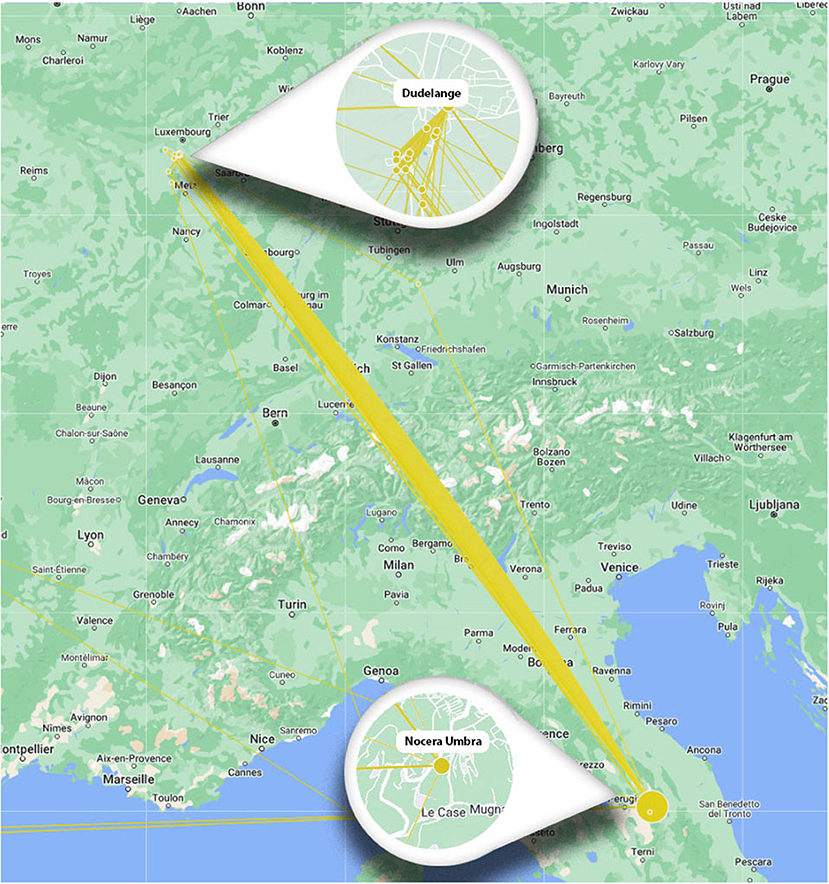
Figure 14. Visualization of the direct migration path of 28 Italian migrants from Nocera Umbra to Dudelange in 1924.
The direct migration path from Nocera Umbra to Dudelange indicates that family members and acquaintances followed earlier cohorts of migrants or that locals were recruited in Italy to come and work in Luxembourg (Gallo, 1987, p. 73–75). Official recruiters like Giulio Moschen, an Italian worker-entrepreneur in Dudelange, originally from Levico Terme in the province of Trento, traveled to Italy to recruit workers on behalf of the ARBED company (Reitz, 1984, p. 83–84; Wiegandt-Sakoun, 1986, p. 471–480). Other migrant workers were approached directly at customs posts or in major stations. In the 1920s, Italian migration slowed down because the Italian government tightened its control over emigration, and Luxembourg industrialists turned to other places: Poland, the Kingdom of Serbs, Croats and Slovenes, and the Ruhr region (Pairault, 1928, p. 77–110). For the small dataset used in this study, this consecutive mapping could also have been achieved using a more conventional approach, such as consecutive selection options in an Excel file. For the bigger dataset that we aim to compose in the future, however, this would no longer be possible.
Mapping spatiotemporal data from two towns
Geographic visualization offered us the possibility to map the spatiotemporal data from Dudelange and Differdange together and to analyze the mobility of migrants between these two towns. Only 21 declaration forms from Dudelange and Differdange mention a place of residence in these two municipalities. The migrants were skilled German workers, such as metal workers. There was also a small proportion of apprentices in foods trades (e.g., butchers or bakers). Let us look at the case of the Engelberty brothers, which represents a fairly typical form of family migration.23 Like many German migrants, Nicolaus and Jakob originated from the border area that had been part of Luxembourg until 1815. The two brothers were born respectively in 1896 and 1900 in Gashof, a few kilometers from the German-Luxembourgish border. Their forms indicate residence in Dudelange on April 16, 1924 and a job as “Hüttenarbeiter” at the main steel and mining company. Aged 24 and 28 and both single, nothing seems to have been able to retain them in their rural home region, a source of emigration for decades, in particular to the industrial south of Luxembourg.
The two brothers did not come directly to Dudelange. Both were recorded on the same day, but 2 months earlier, in Differdange, where they were hired as “Hüttenarbeiter” at the Hadir steelworks. We observed a relative nomadism for workers, who moved quite easily from one company to another during an economic boom. The brothers' declaration forms in Differdange tell us that they were not on their first stay in Luxembourg. Jakob was registered for the first time in June 1922 in Roedgen, while Nicolaus lived in Landscheid from July 1923 onwards. In these rural towns, the brothers were probably hired as agricultural workers and continued what they had learned on the family farm. Once their contracts had come to an end, the brothers left Luxembourg and found themselves in early 1924 in Waldhof, a German border town only separated from the Luxembourg town of Vianden by the Our river. It was from there that they both went to Differdange with their passports obtained on January 18, 1923 at the German Embassy in Luxembourg and their foreigner's booklet authorizing them to work legally. In both Differdange and Dudelange, the brothers lived together at the same addresses not far from the steelworks where they worked.
Although Jakob and Nicolaus should have mentioned their first entry into Luxembourg when arriving in Dudelange, they did not, and this information can only be retrieved by consulting their declaration forms in Differdange. Successive declarations for the same individual can be used to provide more comprehensive data on the migratory trajectory of declarants. The potential unreliability of residence data in declaration forms caused by the fact that declarants did not always present the same papers to civil servants tends to disappear when more data of an individual can be taken into account. This leads us to identify more detailed trajectories within and outside Luxembourg (Figure 15).
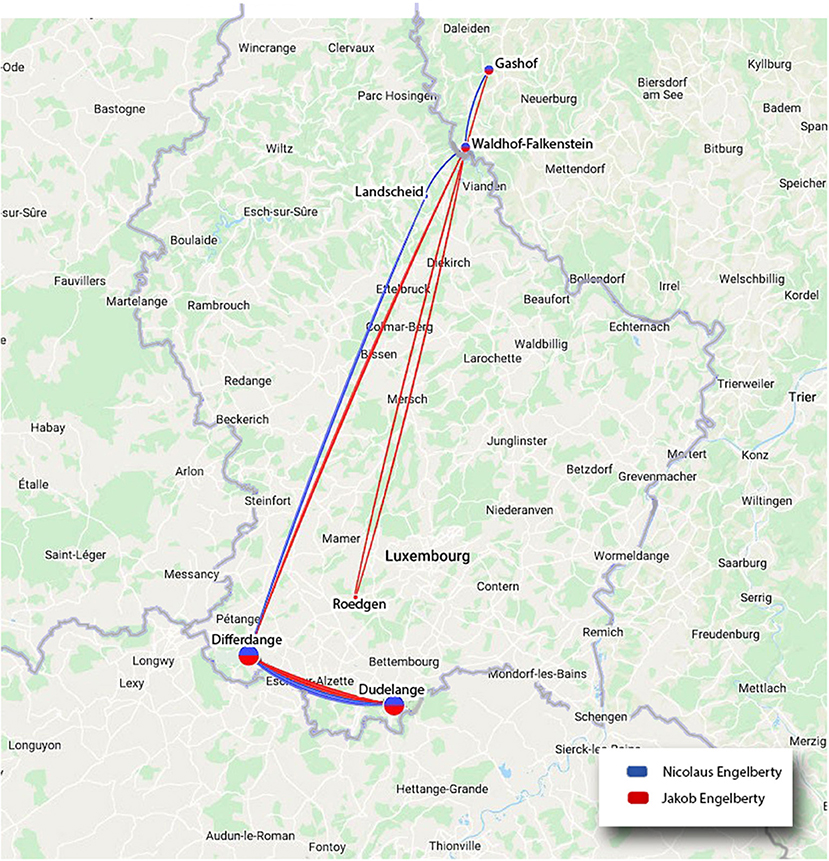
Figure 15. Migration paths of the brothers Jakob and Nicolas Engelberty between Germany and Luxembourg.
A social network analysis of waiting
More than 20 years ago, Dirk Hoerder encouraged researchers to decipher the importance of networks of individuals in order to understand migrations in the past (Hoerder, 1997, p. 85). Taking the example of Trieux, which was a popular short-term destination in Lorraine for migrants on the way from Italy to Luxembourg, we will indicate how social networking functioned for migrants on the road, and discuss the limits of nodegoat in visualizing this phenomenon accurately.
In Lorraine, major German and Italian communities emerged at the end of the 19th century following the establishment of new mines and factories. Algrange was referred to as “little Berlin,” and Italian migrants gathered in industrial towns in the Orne and Fensch valleys. A consulate was opened in Nancy in October 1911 and a consular agency followed in the district of Briey, to which Trieux belonged, in 1912. In 1913, that district numbered 46,700 Italians out of 75,000 foreigners (Bonnet et al., 1962, p. 92). The Sancy mine in Trieux was opened in 1903 and the town grew from 258 inhabitants in 1901 to 1,924 in 1911, the majority of whom were Italian workers. Trieux functioned as a stopover that was frequently cited by Italians arriving in Dudelange. One Italian who received financial compensation for a work accident in Luxembourg moved to Trieux, where he built a wooden hut that he rented out to newcomers from Italy (Jeandin, 1977, p. 29).
Mapping migration from Italy through Trieux to Dudelange in 1924 showed the migration paths of 14 Italians (Figure 16). However, the dots and lines on the map do not show how migrants used space and time. Figure 17 details the migrants' trajectories differently with a temporal social network visualization composed in the software program Tableau, demonstrating how social networks operated during migrants' trajectories. It shows us who traveled together during the first part of the journey (e.g., Onorato Biagotti and Domenico Fancelli), who waited for whom in Trieux and for how long before traveling alone or together to Dudelange (e.g., Sante Della Bina and the Fabbri siblings waited for Giuseppe Fancelli), as well as how siblings followed each other (e.g., Nati). Based on the available data about Trieux in the database, we could not trace whether spouses traveled from Italy to Trieux alone, waited there for each other, and then traveled together to Dudelange, because upon arrival in Luxembourg the couple was declared on one form and only the migratory path of the male declarant was indicated in detail.
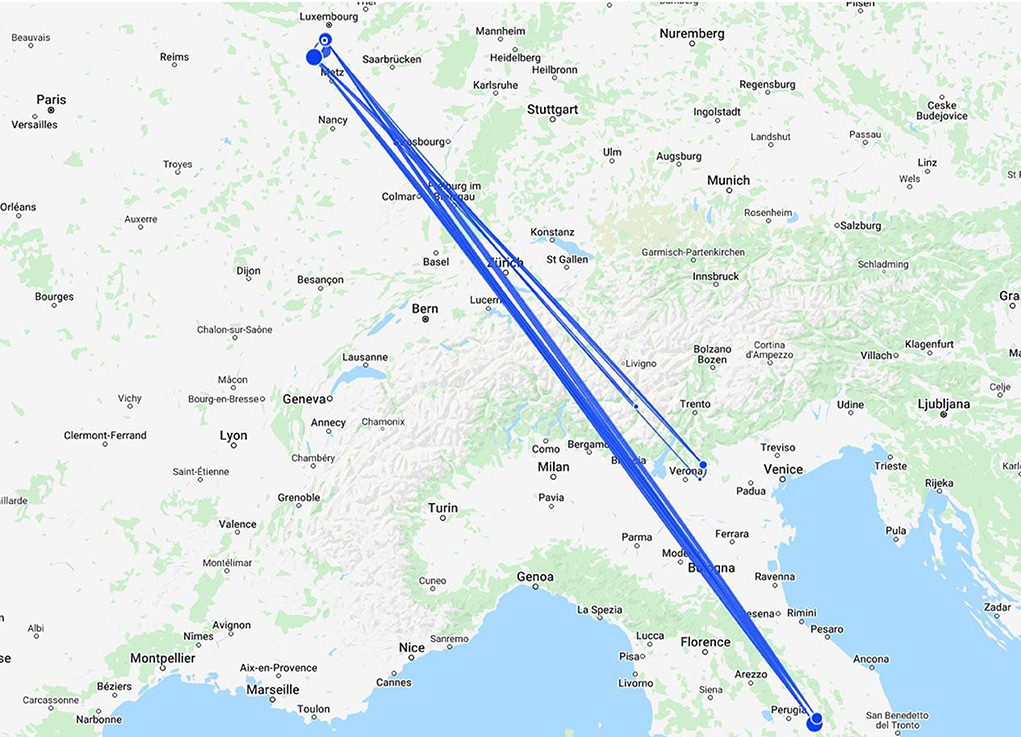
Figure 16. The migration trajectories of Italian migrants who declared residency in the French town of Trieux before arriving in Dudelange.
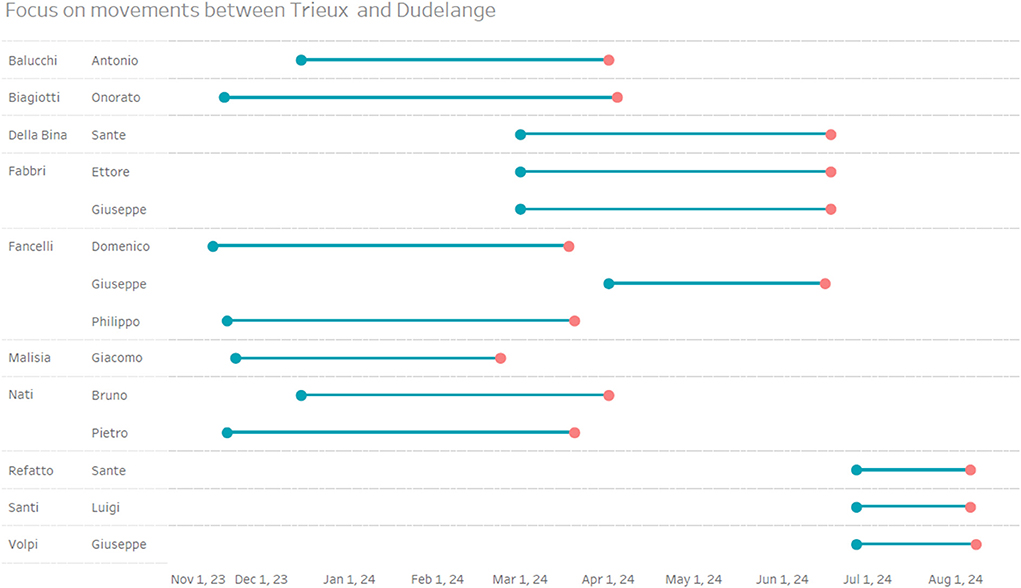
Figure 17. A temporal social network visualization of migration from Italy through Trieux to Dudelange.
Conclusion
Mapping in nodegoat gave us new insights into migration trajectories and settlement patterns of migrants arriving in Dudelange in 1924. The ability to filter according to a vast number of criteria enabled us to decipher trends that would otherwise have been buried in the mass of data. For example, mapping unraveled a detailed relationship between migration and marriage. It also facilitated our work on precise samples through consecutive mapping, which provided knowledge about the personal ties between villages in central Italy and some café-pensions in Dudelange. In addition, our data model allowed us to visualize data from declaration forms of different municipalities together, which made it possible to display more complex migration trajectories. Our digital hermeneutic approach ultimately allowed us to venture beyond nodegoat so that we could create and interpret comparative and cumulative chronological visualizations of the arrival of German and Italian migrants in Dudelange, as well as a temporal social network visualization of Italian migrants traveling to Dudelange through the French town of Trieux.
Visualizing migration data also revealed new avenues for further research. Our analysis of mobility was hampered by the absence of departure data and could be enriched by the data found in tens of thousands of handwritten resident cards of individuals or families produced in the interwar years, which kept track of arrivals and departures.24 Another interesting avenue for further research would be to see when (and how) the mobility of unmarried declarants changed once they married. Preliminary research by Daniel Richter on living patterns in the town of Esch-sur-Alzette indicates that married couples very rarely lived in café-pensions and that unmarried women seemingly only lived in such homes in emergency situations, for example following a dispute with their husbands or in the case of (accused) prostitution (Richter, 2022). This research could be conducted on the basis of data included in the individual files compiled by the Luxembourg Alien Police for each migrant and conserved in the National Archives of Luxembourg. Qualitative sources such as letters from migrants and newspaper articles about migration could inform a more human-oriented approach to space and time modeling, expressing how spaces were made, observed and experienced by migrants themselves (Löw, 2016; Musekamp, 2019; Drucker, 2020).
Another possibility would be to research the often neglected aspect of transnational return migration (Oberbichler and Pfanzelter, 2021). Although sources created by the Luxembourg government were not intended to be used to document return migration, the declaration forms created in 1924 do enable us to document return migration during the First World War. Nodegoat visualizations show many Italian declarants in 1924 had already been residents of Dudelange before the First World War, and that they moved back to Italy within a year of war breaking out (Gallo, 1987, p. 289; Buzzi, 2015).
A last possible avenue for future research is the combined processing of declaration forms over more years and several municipalities within the Minett region, which would make it possible to complete migration data for individual declarants and to display more complex migration trajectories within the borderlands over a longer time period, potentially from a comparative perspective. Including more data will require a different methodological approach, such as the automated linking of historical data (Abramitzky et al., 2019).
Data availability statement
The original sources presented in the study can be consulted in the communal archives of Dudelange and Differdange in the Grand-Duchy of Luxembourg. Further inquiries can be directed to the corresponding author.
Author contributions
MV and AS wrote the article. MV conducted the case study on Dudelange. AS conducted the case study on Differdange. Both authors contributed to the article and approved the submitted version.
Funding
The research for this article was funded by the Luxembourg National Research Fund (FNR) within the project Flows, mobility and networks of the foreign workforce in the crossborder steel basin of the Minette during the inter-war period (Principal Investigator: AS) FNR, Application ID: 12524819.
Acknowledgments
The authors thank Estelle Bunout and Denis Scuto for co-teaching and 30 students for attending the MA course in Contemporary Migration History at the University of Luxembourg in 2021 and 2022. The authors are also grateful to David Jacquet, Benjamin Juchem and Aida Horaniet Ibanez for their research assistance, and to Antoine Paccoud and Tiago Ferreira Flores for sharing their expertise on cadastral sources.
Websites
www.geonames.org, accessed on April 25, 2022. www.geoportail.lu, accessed on April 25, 2022. https://legilux.public.lu, accessed on April 25, 2022.
Conflict of interest
The authors declare that the research was conducted in the absence of any commercial or financial relationships that could be construed as a potential conflict of interest.
Publisher's note
All claims expressed in this article are solely those of the authors and do not necessarily represent those of their affiliated organizations, or those of the publisher, the editors and the reviewers. Any product that may be evaluated in this article, or claim that may be made by its manufacturer, is not guaranteed or endorsed by the publisher.
Footnotes
1. ^The “Hauts-Fourneaux et Aciéries de Differdange, Saint-Ingbert, Rumelange,” a French-Belgian company formed after the First World War from the assets of the German company “Deutsch-Luxemburgische Bergwerks- und Hütten-A.G. of Bochum” located in Luxembourg and Lorraine (France).
2. ^Communal archives of Differdange (further Differdange).
3. ^This first legislative instrument was amended several times, such as in 1911, by a Decree regarding the implementation of the Act.
4. ^The text was modified in July of the same year and then in 1935, 1937, 1938, 1952, 1958 and 1964.
5. ^Legilux: https://legilux.public.lu/eli/etat/leg/loi/1920/10/28/n1/jo.
6. ^DA, Dudelange, 1924, 683 and 814.
7. ^DA, Dudelange, 1924, 786.
8. ^DA, Dudelange, 1924, 1068.
9. ^DA, Dudelange, 1924, 237, 909.
10. ^DA, Dudelange, 1924, 347, 784.
11. ^DA, Dudelange, 1924, 667.
12. ^When Emanuel Saternus arrived in Dudelange in May 1924, this Polish emigrant was registered as a native of Königshütte, a Prussian town in Silesia. When Königshütte became Polish in 1921, it was renamed Chorzów. His wife was from Neuderbor, Pless district, which we were unable to geolocate (DA, Dudelange, 1924, 347).
13. ^Postcard showing the southern part of Hüttenstrasse/Rue des Usines leading toward the steelworks, including the café run by Joseph Hirschberger, born in 1870 in Luxembourg as the son of a Jewish bartender originally from Gerolzhofen in Bavaria, Germany (Municipal Archives of Dudelange, early 20th century).
14. ^Source: Cadastre de Dudelange, Relevé des Actes de Mutations contenant tous les actifs de Propriétés foncières entre le 1 janvier 1932 et le 31 décembre 1940.
15. ^www.geoportail.lu, consulted on April 25, 2022.
16. ^See also: Stadt Düdelingen. Strassenbenennungen, 1956 for imprecise descriptions of changes in street locations.
17. ^See: “Un scandale Boche,” L'Indépendance Luxembourgeoise, 8 octobre 1919, no. 233, p. 1.
18. ^DA, Dudelange, 1924, 319.
19. ^DA, Differdange, 1924, 362; DA, Dudelange, 1924, 667.
20. ^DA, Dudelange, 1924, 563, 564.
21. ^ANLux, CT-03-02-0293.
22. ^DA, Dudelange, 1924, 449, 576, 944.
23. ^DA, Differdange, 1924, 178, 179; DA, Dudelange, 1924, 245, 246.
24. ^Example: The resident card of Anton Vukovic indicating the dates of successive entries to (April 26, 1928 and September 9, 1928) and exits (July 9, 1928 and July 7, 1931) from Dudelange (Communal Archives of Dudelange).
References
Abramitzky, R., Mill, R., and Pérez, S. (2019). Linking Individuals Across Historical Sources: A Fully Automated Approach. Cambridge: National Bureau of Economic Research, Working Paper 24324. doi: 10.3386/w24324
Blanc-Chaléard, M.-Cl., Bechelloni, A., Deschamps, B., Dreyfus, M., and Vial, É. (eds.) (2007). Les Petites Italies dans le monde. Rennes: Presses universitaires de Rennes. doi: 10.4000/books.pur.6543
Bonnet, S. (1976). L'Homme du fer, Mineurs de fer et ouvriers sidérurgistes lorrains, vol. 1. Nancy: Centre Lorrain d'Études Sociologiques.
Bonnet, S., Santini, Ch., and Barthélemy, H. (1962). Les Italiens dans l'arrondissement de Briey avant 1914. Nancy: Berger-Levrault. p. 92.
Burdick, A., Drucker, J., Lunenfeld, P., Presner, T., and Schnapp, J. (2016). Digital Humanities. Cambridge, Massachusetts: MIT Press.
Burrows, T. (2017). The History and Provenance of Manuscripts in the Collection of Sir Thomas Phillipps: New Approaches to Digital Representation. Speculum 92/1, 39–64. doi: 10.1086/693438
Buzzi, P.-L. (2015). Les immigrés italiens en Lorraine française pendant la Première Guerre mondiale (1914-1918) (Master's dissertation supervised by Jean-Noël Grandhomme), Université de Strasbourg.
Chomé, F. (1964). ARBED, Un demi-siècle d'histoire industrielle, 1911-1964. Luxembourg: ARBED/Aciéries Réunies de Burbach-Eich-Dudelange.
Drucker, J. (2020). Visualization and Interpretation: Humanistic Approaches to Display. Cambridge, Massachusetts; London, England: The MIT Press. doi: 10.7551/mitpress/12523.001.0001
Faassen, M. V., and Hoekstra, R. (2022). Migrant visibility: Digitization and heritage policies. Front. Hum. Dyn. 4, 908456. doi: 10.3389/fhumd.2022.908456
Gallo, B. (1987). Les Italiens au Grand-Duché de Luxembourg, Un siècle d'histoire et de chroniques sur l'immigration. Luxembourg: Imprimerie Saint-Paul.
Galloro, P.-D. (2001). Ouvriers du fer, princes du vent, Histoire des flux de main-d'œuvre dans la sidérurgie lorraine (1880-1939). Metz: Éditions Serpenoise.
Graham, S., Milligan, I., and Weingart, S. (2016). Exploring Big Historical Data: The Historian's Macroscope. London: Imperial College Press. doi: 10.1142/p981
Hayles, N. K. (2012). How We Think: Digital Media and Contemporary Technogenesis. Chicago and London: Chicago University Press. doi: 10.7208/chicago/9780226321370.001.0001
Hoerder, D. (1997). “Segmented macrosystems, networking individuals, cultural change: balancing processes and interactive change in migration,” in Citizenship and Exclusion, ed V. Bader (Houndsmill: Palgrave Macmillan), 81–95. doi: 10.1057/9780230374591_5
Hohengarten, A. (1995). “‘Polonia’ oder die polnische Immigration in Luxemburg im 20. Jahrhundert,“ in Itinéraires croisés, Luxembourgeois à l'étranger, étrangers au Luxembourg/Menschen in Bewegung, Luxemburger im Ausland, Fremde in Luxemburg, eds A. Reuter and D. Scuto (Luxembourg: Éditions Le Phare), 194–199.
Jeandin, J. (1977). Trieux, Soixante-dix-neuf jours au fond pour la Lorraine. Paris: Social Éditions.
Klessmann, Ch. (1978). Polnische Bergarbeiter im Ruhrgebiet: 1870-1945. Göttingen: Brill GmbH. doi: 10.13109/9783666359828
Leboutte, R., Puissant, J., and Scuto, D. (1998). Un siècle d'histoire industrielle (1873-1973), Belgique, Luxembourg, Pays-Bas, Industrialisation et sociétés. Paris: Éditions SEDES. doi: 10.3917/sedes.lebou.1998.01
Lehners, J.-P. (1991). “Wohnen in Düdelingen zu Beginn des 20. Jahrhunderts,” in Tageblatt 222 (Esch-sur-Alzette: Tageblatt), 9–12.
Löw, M. (2016). The Sociology of Space – Materiality, Social Structures and Action. Cultural Sociology. Houndsmill: Palgrave Macmillan. doi: 10.1057/978-1-349-69568-3
McCarty, W. (2005). Humanities Computing. Houndsmill: Palgrave Macmillan. doi: 10.1057/9780230504219
McKinsey, L., and Konrad, V. (1989). Borderlands Reflections: The United States and Canada. Orono, Me: University of Maine.
Musekamp, J. (2019). “Big history and local experiences: migration and identity in a European Borderland,” in Mapping Migration, Identity, and Space, eds. T. Linhard and T. Parsons (Houndsmill: Palgrave Macmillan), 55–83. doi: 10.1007/978-3-319-77956-0_3
Oberbichler, S., and Pfanzelter, E. (2021). Topic-specific corpus building: a step towards a representative newspaper corpus on the topic of return migration using text mining methods. J. Dig. Hist. 1, 74–98. doi: 10.1515/jdh-2021-1003
Pairault, A. (1928). L'Immigration organisée et l'emploi de la main-d'œuvre étrangère en France. Paris: PUN.
Palomba, P., Montanari, R., and Garzia, E. (2020). “FORMAL. Mapping Fountains over Time and Place. Mappare il movimento delle fontane monumentali nel tempo e nello spazio attraverso la geovisualizzazione,” in Digitized and Digitalized Humanities: Words and Identity. Atti del IX Convegno Annuale AIUCD. La svolta inevitabile: sfide e prospettive per l'Informatica Umanistica, AIUCD, ed C. Clivaz (Milano: AIUCD), 67–73.
Petruş, A. (2020). Network Analyses of Foreign Travelers Through Wallachia, Moldavia and Transylvania Between 1831-1840. Studia Universitatis Babe?-Bolyai – Digitalia 65/2, 31–47. doi: 10.24193/subbdigitalia.2020.2.03
Pisarevskaya, A., Levy, N., Scholten, P., and Jansen, J. (2020). Mapping Migration Studies: An Empirical Analysis of the Coming of Age of a Research Field. Migration Studies 8/3, 455–481. doi: 10.1093/migration/mnz031
Ponty, J. (2005). Polonais méconnus, Histoire des travailleurs immigrés en France dans l'entre-deux-guerres. Paris: Publications de la Sorbonne.
Presner, T., and Shepard, D. (2015). “Mapping the geospatial turn,” in A New Companion to Digital Humanities, eds S. Schreibman, R. Siemens, and J. Unsworth (New York: John Wiley and Sons), 199–212. doi: 10.1002/9781118680605.ch14
Rainhorn, J., (ed.). (2005). Petites Italies dans l'Europe du Nord-Ouest, Valenciennes: Presses universitaires de Valenciennes.
Reisinger, G. (2010). “Digital source criticism: net art as a methodological case study,” in Netpioneers 1.0: Contextualizing Early Net-Based Art, eds D. Daniels and G. Riesinger (Berlin: Sternberg Press), 123–142.
Reitz, J. (1984). L'immigration étrangère à Differdange au début du XXe siècle (1898-1914), Mémoire de maîtrise sous la direction de François Roth, Université de Nancy II.
Reuter, A. (2018). “La ville de Dudelange à la veille de la Première Guerre mondiale, un étonnant laboratoire du vivre en commun,” in Être d'ailleurs en temps de guerre (1914-1918), Étrangers à Dudelange, Dudelangeois à l'étranger, Mutations, Mémoires et perspectives du bassin minier, no. 10 (Luxembourg: Fondation Bassin Minier), 31–39.
Richter, D. (2022). “Making home in the neighborhoods of Esch-sur-Alzette (LU) during the first half of the 20th century,” in Paper Presented at the International Migration Conference in Dudelange on June 16, 2022 (Dudelange).
Schrover, M., and Moloney, D. M. (2013). Gender, Migration and Categorisation: Making Distinctions Between Migrants in Western Countries, 1945-2010. Amsterdam: Amsterdam University Press.
Scuto, D. (2010). “Histoire des immigrations au Luxembourg (XIXe-XXIe siècles),” in 25 ans d'action pour l'immigration, 1985-2010, OGBL, 25ème anniversaire du Département des Immigrés (Luxembourg: OGBL/Département des Immigrés), 13–38.
Scuto, D. (2012). La nationalité luxembourgeoise (XIXe-XXIe siècles). Brussels: Éditions de l'Université de Bruxelles.
Shaw-Taylor, Y., and McCall, L. (2020). Immigration, Assimilation, and Border Security. Lanham: Bernan Press.
Stiegler, B. (2014). Digital Studies: organologie des savoirs et technologies de la connaissance. Limoges: Fyp éditions.
Trausch, G. (2017). Histoire économique du Grand-Duché de Luxembourg, 1815-2015. Luxembourg: Imprimerie Centrale S.A.
Trinkaus, F. (2014). Arbeiterexistenzen und Arbeiterbewegung in den Hüttenstädten Neunkirchen, Saar und Düdelingen, Luxemburg: 1880-1935/40: ein historischer Vergleich. Saarbrücken: Kommission für Saarländische Landesgeschichte.
van Bree, P., and Kessel, G. (2017). Iterative Data Modelling. From Teaching Practice to Research Method. Abstract retrieved from Digital Humanities Montreal database.
Walter, G. (1935). L'évolution du problème de la main-d'œuvre dans la métallurgie de la Lorraine. Mâcon: J. Buguet-Comptour.
Weitin, T. (2017). Scalable reading. Zeitschrift für Literaturwissenschaft und Linguistik 47, 1–6. doi: 10.1007/s41244-017-0048-4
Wiegandt-Sakoun, C. (1986). “Les missions catholiques italiennes dans l'entre-deux-guerres: l'exemple français,” in Les Italiens en France de 1914 à 1919, ed P. Milza (Rome: École française de Rome), 471–480.
Williams, L. (2013). “Transnational marriage migration and marriage migration,” in Transnational Marriage. New Perspectives from Europe and Beyond, ed K. Charley (New York, NY: Routledge), 32–46. doi: 10.4324/9780203111772-9
Zephyr, F. (2015). “Spatial history as scholarly practice,” in Between Humanities and the Digital, eds P. Svensson and D. T. Goldberg (London and Cambridge: MIT Press), 411–428.
Keywords: mapping, Luxembourg, Germany, Italy, digital hermeneutics, migration, history
Citation: Venken M and Sauer A (2022) Arrival declaration forms. A new gateway for mapping migration to Luxembourg. Front. Hum. Dyn. 4:931758. doi: 10.3389/fhumd.2022.931758
Received: 29 April 2022; Accepted: 21 October 2022;
Published: 24 November 2022.
Edited by:
Juan Sebastián Fernández-Prados, University of Almeria, SpainReviewed by:
Saara Kekki, University of Helsinki, FinlandHeidi Martins, Centre de Documentation Sur les Migrations Humaines, Luxembourg
Andrew Shield, Leiden University, Netherlands
Piero Galloro, Université de Lorraine, France
Copyright © 2022 Venken and Sauer. This is an open-access article distributed under the terms of the Creative Commons Attribution License (CC BY). The use, distribution or reproduction in other forums is permitted, provided the original author(s) and the copyright owner(s) are credited and that the original publication in this journal is cited, in accordance with accepted academic practice. No use, distribution or reproduction is permitted which does not comply with these terms.
*Correspondence: Machteld Venken, bWFjaHRlbGQudmVua2VuQHVuaS5sdQ==
 Machteld Venken
Machteld Venken Arnaud Sauer
Arnaud Sauer